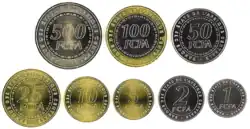Central African CFA franc
The Central African CFA franc (French: franc CFA or simply franc; ISO code: XAF; abbreviation: F.CFA) is the currency of six independent states in Central Africa: Cameroon, Central African Republic, Chad, Republic of the Congo, Equatorial Guinea and Gabon. These six countries have a combined population of 55.2 million people (as of 2020),[1] and a combined GDP of over US$100 billion (as of 2021).[2]
| franc CFA BEAC (French) | |||||
|---|---|---|---|---|---|
| |||||
| ISO 4217 | |||||
| Code | XAF (numeric: 950) | ||||
| Unit | |||||
| Symbol | F.CFA | ||||
| Nickname | céfa, franc | ||||
| Denominations | |||||
| Subunit | |||||
| 1⁄100 | centime theoretical (unused) | ||||
| Symbol | |||||
| centime | c | ||||
| Banknotes | 500, 1,000, 2,000, 5,000, 10,000 francs | ||||
| Coins | 1, 2, 5, 10, 25, 50, 100, 500 francs | ||||
| Demographics | |||||
| User(s) | |||||
| Issuance | |||||
| Central bank | Bank of Central African States | ||||
| Website | www | ||||
| Valuation | |||||
| Pegged with | €1 = F.CFA 655.957 | ||||

CFA originally stood for Colonies françaises d'Afrique ("French colonies of Africa"); following the independence of these states, its name was changed to Coopération financière en Afrique centrale ("Financial Cooperation in Central Africa"). The currency is issued by the Bank of Central African States (BEAC; Banque des États de l'Afrique Centrale), located in Yaoundé, Cameroon, for the members of the Economic and Monetary Community of Central Africa (CEMAC; Communauté Économique et Monétaire de l'Afrique Centrale). The franc is nominally subdivided into 100 centimes but no centime denominations have been issued. The production of CFA franc notes has been carried out at Chamalières by the Bank of France since its creation in 1945.
In several west African states, the West African CFA franc, which is of equal value to the Central African CFA franc, is in circulation.
History
The CFA franc was introduced to the French colonies in Equatorial Africa in 1945, replacing the French Equatorial African franc. The Equatorial African colonies and territories using the CFA franc were Chad, French Cameroun, French Congo, Gabon and Ubangi-Shari.
The currency remained in use when these colonies gained their independence. Equatorial Guinea, the only former Spanish colony in the zone, adopted the CFA franc in 1984, replacing the Equatorial Guinean ekwele at a rate of 1 franc = 4 bipkwele.
The currency was pegged to the French franc (F) at F.CFA 1 = 2 French francs from 1948, becoming F.CFA 1 = NF 0.02 after introduction of the new franc at 1 new franc = 100 old francs. In 1994 the currency was devalued by half to F.CFA 1 = F 0.01. From 1999 it has since been pegged to the euro at €1 = F 6.55957 = F.CFA 655.957.
On April 25, 2023, the ministerial meeting of the Economic and Monetary Community of Central Africa (Cemac) and France is held. In particular, the subject of the CFA franc was discussed. On the French side, the guarantee provided to the CFA franc, and the assurance of its convertibility, is perceived as a vector of economic stability for the region. France remains “open” and “available” to move forward on a reform of monetary cooperation in Central Africa, such as it has been able to take place in West Africa. France says it is ready to receive CEMAC's proposals..
Criticism
According to the BBC, "critics, such as those leading the anti-CFA movement, say true economic development for the 14 African countries can only be achieved if they get rid of the currency. They argue that in exchange for the guarantees provided by the French treasury, African countries channel more money to France than they receive in aid. They also argue that they have no say in deciding key monetary policies agreed to by European countries, which are members of the Eurozone."[3]
Coins
In 1948, coins were issued for use in all the colonies (not including French Cameroun) in denominations of 1 and 2 francs. This was the last issue of a 2 franc coin for nearly 50 years. In 1958, 5, 10, and 25 franc coins were added, which were also used in French Cameroun. These bore the name Cameroun in addition to États de l'Afrique Equatoriale. In 1961, nickel 50 franc coins were introduced, followed by nickel 100 franc pieces in 1966.
From 1971, the 100 franc coins were issued for each of the individual member states, depicting the state name in which they were issued. 50 franc coins were also issued in this manner between 1976 and 1996, after being reduced in size. However instead of depicting the state name each was given an identification letter on the top reverse. 50 franc coins with the letter "A" were issued for Chad, "B" for Central African Republic, "C" for Congo, "D" for Gabon, and "E" for Cameroon. In 1976, cupro-nickel 500 franc coins were introduced. From 1985, these were also issued by the individual states. That year also saw the introduction of 5, 25, 50 and 100 franc coins for use in Equatorial Guinea, which had recently joined the monetary union, depicting all titles and information in Spanish instead of the usual French, most notably the denomination as "franco" instead of "franc". Despite titular differences in some of the coinage, all were legal and exchangeable tender in all member nations.
In 1996, centralized production of the 100 franc coin was resumed, with a single 500 franc coin reintroduced in 1998. Despite dropping state names and code letters, the overall design of the coins remained relatively unchanged.
2006 saw a redesign of all denominations of coins for the CFA franc, along with the introduction of a 2 franc piece. The 1, 5, 10, and 25 franc coins were reduced in size, while a new bi-metallic 100 franc coin was introduced, along with a new and reduced size 500 franc coin with heightened security features, including laser marking. All newer coins depict the acronym "CEMAC" for "Communauté Économique et Monétaire de l'Afrique Centrale". Older sized coins continue to remain legal tender alongside the newly configured coins.
All CFA coins depict both a mint mark, along with an engraver's privy mark. The mint mark is located on the reverse on the left side of the denomination while the engraver's mark is located on the right.
| Coins of the Central African CFA franc | |||||||||
|---|---|---|---|---|---|---|---|---|---|
| Image | Value | Technical parameters | Description | Date of first minting | |||||
| Diameter | Thickness | Mass | Composition | Edge | Obverse | Reverse | |||
| 1 franc | 14.94 mm | 1.39 mm | 1.65 grams | Stainless steel | Smooth | Numeral "1"; legend "BANQUE DES ÉTATS DE L'AFRIQUE CENTRALE" and "1 FCFA" | Denomination above agricultural products (two shrubs of cacao and cassava); legend "CEMAC" | 2006 | |
| 2 francs | 18 mm | 1.4 mm | 2.45 grams | Stainless steel | Smooth | Numeral "2"; legend "BANQUE DES ÉTATS DE L'AFRIQUE CENTRALE" and "2 FCFA" | Denomination above agricultural products (two shrubs of cacao and cassava); legend "CEMAC" | 2006 | |
| 5 francs | 15.9 mm | 1.65 mm | 2.41 grams | Brass | Smooth | Numeral "5"; legend "BANQUE DES ÉTATS DE L'AFRIQUE CENTRALE" and "5 FCFA" | Denomination above agricultural products (two shrubs of cacao and cassava); legend "CEMAC" | 2006 | |
| 10 francs | 18 mm | 1.67 mm | 3 grams | Brass | Reeded | Numeral "10"; legend "BANQUE DES ÉTATS DE L'AFRIQUE CENTRALE" and "10 FCFA" | Denomination above agricultural products (two shrubs of cacao and cassava); legend "CEMAC" | 2006 | |
| 25 francs | 22.75 mm | 1.55 mm | 4.2 grams | Brass | Reeded | Numeral "25"; legend "BANQUE DES ÉTATS DE L'AFRIQUE CENTRALE" and "25 FCFA" | Denomination above agricultural products (two shrubs of cacao and cassava); legend "CEMAC" | 2006 | |
| 50 francs | 22 mm | 1.93 mm | 5 grams | Stainless steel | Indented | Numeral "50"; legend "BANQUE DES ÉTATS DE L'AFRIQUE CENTRALE" and "50 FCFA" | Denomination above agricultural products (two shrubs of cacao and cassava); legend "CEMAC" | 2006 | |
| 100 francs | 24 mm | 2 mm | 6 grams | Bi-metallic (Stainless steel center plug with a brass outer ring) | Reeded | Numeral "100"; legend "BANQUE DES ÉTATS DE L'AFRIQUE CENTRALE" and "100 FCFA" | Denomination above agricultural products (two shrubs of cacao and cassava); legend "CEMAC" | 2006 | |
| 500 francs | 26 mm | 2.03 mm | 8 grams | Copper-nickel | Lettered (5 sets of 15 reeds and the non-aligned acronym "CEMAC" (Economic and Monetary Community of Central Africa) repeated 8 times alternatively up and down) | Numeral "500"; legend "BANQUE DES ÉTATS DE L'AFRIQUE CENTRALE" and "500 FCFA" | Denomination above agricultural products (two shrubs of cacao and cassava); legend "CEMAC" | 2006 | |
Banknotes
When the CFA franc was introduced, notes issued by the Caisse Centrale de la France d'Outre-Mer ("Central Cashier of Overseas France") in denominations of 5, 10, 20, 100, and 1,000 francs were in circulation. In 1947, a new series of notes was introduced for use in French Equatorial Africa, although the notes did not bear the name of the colonies. Notes were issued in denominations of 5, 10, 20, 50, 100, and 1,000 francs, followed by those of 500 francs in 1949, and 5,000 francs in 1952. In 1957, the Institut d'Émission de l'Afrique Équatoriale Française et du Cameroun took over paper money production, issuing all of the earlier denominations except for the 500 -franc bill.
In 1961, the Banque Centrale des États de l'Afrique Équatoriale et du Cameroun took over banknote production, with notes below 100 francs ceasing to be issued. The name of the bank changed to Banque Centrale des États de l'Afrique Équatoriale in 1963. 10,000 franc notes were introduced in 1968, whilst the 10 franc notes were replaced by coins in 1971.
In 1975, the bank name changed again to the Banque des États de l'Afrique Centrale and the individual states began issuing notes in their own names, in denominations of 500, 1,000, 5,000 and 10,000 francs. This practice ended in 1993. Since then, the banknotes have been issued with only a letter prominently displayed to distinguish between the issues of the different states. 2,000 franc notes were introduced in 1993. The country letter codes are as follows:
1993 series:
- C –
 Republic of the Congo
Republic of the Congo - E –
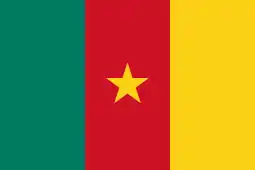 Cameroon
Cameroon - F –
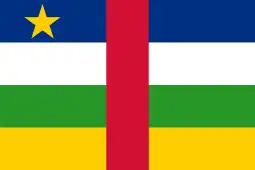 Central African Republic
Central African Republic - L –
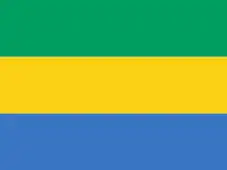 Gabon
Gabon - N –
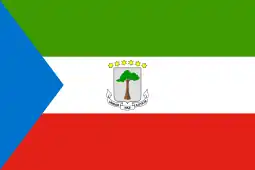 Equatorial Guinea
Equatorial Guinea - P –
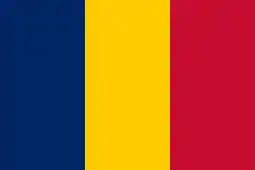 Chad
Chad
2002 series:
- A –
 Gabon
Gabon - C –
 Chad
Chad - F –
 Equatorial Guinea
Equatorial Guinea - M –
 Central African Republic
Central African Republic - T –
 Republic of the Congo
Republic of the Congo - U –
 Cameroon[4]
Cameroon[4]
| Banknotes of the Central African CFA franc (1993-1994 issue) | |||||||||
|---|---|---|---|---|---|---|---|---|---|
| Image | Value | Obverse | Reverse | Remark | |||||
| [5] | 500 francs | Zebus; man | Antelope | C (Republic of the Congo); E (Cameroon); F (Central African Republic); L (Gabon); N (Equatorial Guinea); P (Chad) | |||||
| [6] | 1,000 francs | Coffee harvest; man | Raft | C (Republic of the Congo); E (Cameroon); F (Central African Republic); L (Gabon); N (Equatorial Guinea); P (Chad) | |||||
| [7] | 2,000 francs | Tropical fruit; woman | Harbor scene | C (Republic of the Congo); E (Cameroon); F (Central African Republic); L (Gabon); N (Equatorial Guinea); P (Chad) | |||||
| [8] | 5,000 francs | Oil rig workers | Cotton harvest | C (Republic of the Congo); E (Cameroon); F (Central African Republic); L (Gabon); N (Equatorial Guinea); P (Chad) | |||||
| [9] | 10,000 francs | Building of Banque des États de l'Afrique Centrale (Bank of the Central African States) building; Yaoundé, Cameroon; woman | Fishery | C (Republic of the Congo); E (Cameroon); F (Central African Republic); L (Gabon); N (Equatorial Guinea); P (Chad) | |||||
| Banknotes of the Central African CFA franc (2002 issue) | |||||||||
|---|---|---|---|---|---|---|---|---|---|
| Image | Value | Obverse | Reverse | Remark | |||||
| [10] | 500 francs | Classroom scene, with students learning about the French letter B | Woman; huts | A (Gabon); C (Chad); F (Equatorial Guinea); M (Central African Republic); T (Republic of the Congo); U (Cameroon) | |||||
| [11] | 1,000 francs | Logging; man | Fieldwork | A (Gabon); C (Chad); F (Equatorial Guinea); M (Central African Republic); T (Republic of the Congo); U (Cameroon) | |||||
| [12] | 2,000 francs | Hydroelectric dam; girl | Mining scene | A (Gabon); C (Chad); F (Equatorial Guinea); M (Central African Republic); T (Republic of the Congo); U (Cameroon) | |||||
| [13] | 5,000 francs | Port; man | Oil pumping station | A (Gabon); C (Chad); F (Equatorial Guinea); M (Central African Republic); T (Republic of the Congo); U (Cameroon) | |||||
| [14] | 10,000 francs | Building of Banque des États de l'Afrique Centrale (Bank of the Central African States) building; Yaoundé, Cameroon; woman | Transport and communication | A (Gabon); C (Chad); F (Equatorial Guinea); M (Central African Republic); T (Republic of the Congo); U (Cameroon) | |||||
| Banknotes of the Central African CFA franc (2022 issue) | |||||||||
|---|---|---|---|---|---|---|---|---|---|
| Image | Value | Obverse | Reverse | Remark | |||||
| [15] | 500 francs | Building of Banque des États de l'Afrique Centrale (Bank of the Central African States) building; Yaoundé, Cameroon; | The primary colours are gray, yellow, blue, green, and orange. The central theme of this note is modern agriculture. Security features include a solid security thread with CEMAC, a watermark (three eland antelope heads), and electrotype 500 | A (Gabon); C (Chad); F (Equatorial Guinea); M (Central African Republic); T (Republic of the Congo); U (Cameroon) | |||||
| [16] | 1,000 francs | Building of Banque des États de l'Afrique Centrale (Bank of the Central African States) building; Yaoundé, Cameroon; | The main colours are blue, yellow, red, green, and brown. The main theme of this note is health care. Security features include a solid security thread with CEMAC, a watermark (three eland antelope heads), and electrotype 1000. | A (Gabon); C (Chad); F (Equatorial Guinea); M (Central African Republic); T (Republic of the Congo); U (Cameroon) | |||||
| [17] | 2,000 francs | Building of Banque des États de l'Afrique Centrale (Bank of the Central African States) building; Yaoundé, Cameroon; | Red, yellow, green, and gray are the main colours in this note. The theme of this note is environmental protection and fauna. Security features include Silkscreen OVI® green-to-blue stars, a Dualtrack™ color-changing windowed security thread with demetalized BEAC 2000, a watermark (three eland antelope heads), and electrotype 2000. | A (Gabon); C (Chad); F (Equatorial Guinea); M (Central African Republic); T (Republic of the Congo); U (Cameroon) | |||||
| [18] | 5,000 francs | Building of Banque des États de l'Afrique Centrale (Bank of the Central African States) building; Yaoundé, Cameroon; | The colour scheme here is green, yellow, red, brown, and gray. The primary theme on the back side is environmental protection and fauna. Security features include SPARK Live® gold-to-green with Truspin® effect stars; a RAPID® windowed security thread with BEAC 5000; a watermark (three eland antelope heads); and electrotype 5000. | A (Gabon); C (Chad); F (Equatorial Guinea); M (Central African Republic); T (Republic of the Congo); U (Cameroon) | |||||
| [19] | 10,000 francs | Building of Banque des États de l'Afrique Centrale (Bank of the Central African States) building; Yaoundé, Cameroon; | Purple, yellow, red, green, and orange are the main colours. The main theme on the back side is education. Security features include SPARK Live® magenta-to-green with Truspin® effect stars, a RAPID® windowed security thread with BEAC 10000, a watermark (three eland antelope heads), and electrotype 10000. | A (Gabon); C (Chad); F (Equatorial Guinea); M (Central African Republic); T (Republic of the Congo); U (Cameroon) | |||||
| Current XAF exchange rates | |
|---|---|
| From Google Finance: | AUD CAD CHF CNY EUR GBP HKD JPY USD XOF CDF NGN |
| From Yahoo! Finance: | AUD CAD CHF CNY EUR GBP HKD JPY USD XOF CDF NGN |
| From XE.com: | AUD CAD CHF CNY EUR GBP HKD JPY USD XOF CDF NGN |
| From OANDA: | AUD CAD CHF CNY EUR GBP HKD JPY USD XOF CDF NGN |
See also
- African Central Bank
- African and Malagasy Union (AMU)
- Council of Arab Economic Unity (CAEU)
- Economic Community of West African States
- French Equatorial African franc
- West African CFA franc
General:
References
- Population Reference Bureau. "2014 World Population Data Sheet" (PDF). Prb.org. Archived (PDF) from the original on 2018-02-18. Retrieved 2017-08-25.
- World Bank. "Gross domestic product 2012" (PDF). Databank.worldbank.org. Archived (PDF) from the original on 2017-02-01. Retrieved 2013-10-01.
- "African protests over the CFA 'colonial currency'". BBC News. 30 August 2017. Archived from the original on 2 July 2019. Retrieved 10 June 2019.
- "Central African States banknotes - Central African States paper money catalog and CAS currency history". www.atsnotes.com. Archived from the original on 2022-09-03. Retrieved 2021-05-30.
- "P-101C". banknote.ws. Archived from the original on 10 December 2012. Retrieved 25 August 2017.
- "P-202E". banknote.ws. Archived from the original on 10 December 2012. Retrieved 25 August 2017.
- "P-203E". banknote.ws. Archived from the original on 11 December 2012. Retrieved 25 August 2017.
- "P-204E". banknote.ws. Archived from the original on 11 December 2012. Retrieved 25 August 2017.
- "P-205E". banknote.ws. Archived from the original on 11 December 2012. Retrieved 25 August 2017.
- "P-106T". banknote.ws. Archived from the original on 11 December 2012. Retrieved 25 August 2017.
- "P-207U". banknote.ws. Archived from the original on 11 December 2012. Retrieved 25 August 2017.
- "P-208U". banknote.ws. Archived from the original on 11 December 2012. Retrieved 25 August 2017.
- "P-209U". banknote.ws. Archived from the original on 11 December 2012. Retrieved 25 August 2017.
- "P-210U". banknote.ws. Archived from the original on 11 December 2012. Retrieved 25 August 2017.
- https://platform.keesingtechnologies.com/bank-of-central-african-states-launches-redesigned-banknotes/
- https://platform.keesingtechnologies.com/bank-of-central-african-states-launches-redesigned-banknotes/
- https://platform.keesingtechnologies.com/bank-of-central-african-states-launches-redesigned-banknotes/
- https://platform.keesingtechnologies.com/bank-of-central-african-states-launches-redesigned-banknotes/
- https://platform.keesingtechnologies.com/bank-of-central-african-states-launches-redesigned-banknotes/
External links
- (in French) Communauté Économique et Monétaire de l'Afrique Centrale (Official Site of the Economic and Monetary Community of Central Africa)
- Central African CFA franc Banknotes
| Preceded by: French Equatorial African franc |
Currency of French Equatorial Africa (Chad, Ubangi-Shari, French Congo, Gabon, French Cameroun) 1945 – 1960 |
Currency of Chad 1960 – |
Succeeded by: Current | ||
| Currency of Central African Republic 1960 – 1965 Note: formerly Ubangi-Shari |
Currency of Central African Empire 1965 – 1979 |
Currency of Central African Republic 1979 – | |||
| Currency of Republic of the Congo 1960 – 1970 Note: formerly French Congo |
Currency of People's Republic of the Congo 1970 – 1992 |
Currency of Republic of the Congo 1992 – | |||
| Currency of Gabon 1960 – | |||||
| Currency of Republic of Cameroon 1 January 1960 – 1 October 1961 |
Currency of Federal Republic of Cameroon 1 October 1961 – | ||||
| Preceded by: British West African pound Note: Southern Cameroons joins independent Cameroon | |||||
| Preceded by: Equatorial Guinean ekwele Ratio: 1 CFA franc = 4 bipkwele |
Currency of Equatorial Guinea 1985 – | ||||
.jpg.webp)
